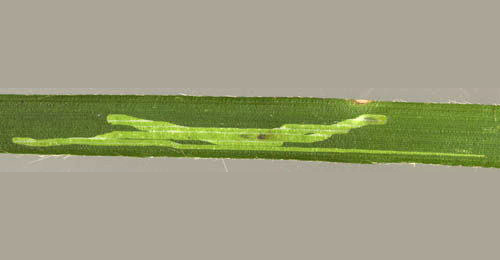|
||||||
| Cerodontha luzulae (Groschke, 1957) [Diptera: Agromyzidae] |
||||||||||||||||||||||||||||||||||||||
|
Phytobia
(Dizygomyza) luzulae Groschke, 1957. Dt. ent. Z. (N.F.)
4: 117 |
||||||||||||||||||||||||||||||||||||||
Leaf-miner: Larva forming irregular linear mine (Spencer, 1990: 345). Makes long upper surface galleries, which may double back on each other. The mines may extend to 20cms of leaf and show up as yellowish against the green leaf. They may also stain purple. The larvae pupate in the mine between late November and January (British leafminers) Rather narrow corridor, upper-surface or interparenchymatous, 12-20 cm in length, about 2 mm wide. Mines yellow, contrasting against the dark green leaves, but sometimes they are deep purple. The corridor changes direction at least twice. Generally it does not leave the blade. Frass in one or two large lumps. Pupation inside the mine (Bladmineerders van Europa).
Larva: The larvae of flies are leg-less maggots without a head capsule (see examples). They never have thoracic or abdominal legs. They do not have chewing mouthparts, although they do have a characteristic cephalo-pharyngeal skeleton (see examples), usually visible internally through the body wall. The larva is described by Nowakowski (1973) and in Bladmineerders van Europa. Puparium: The puparia of flies are formed within the hardened last larval skin or puparium and as a result sheaths enclosing head appendages, wings and legs are not visible externally (see examples). The puparium is illustrated in Bladmineerders van Europa. Hosts in Great Britain and Ireland:
Hosts elsewhere:
Time of year - mines: Larvae in August-October; larvae in the Netherlands in November (Bladmineerders van Europa). Time of year - adults: Currently unknown. Distribution in Great Britain and Ireland: Bland discovered this miner in the UK (Bland (1993a);Entomologist's Gazette 44: 271-273) and found it to be widespread in Southern Scotland - recording it from 11 vice counties (British leafminers). Distribution elsewhere: Widespread in continental Europe including Poland and southern Germany, common in mountain forests (Spencer, 1990: 345), The Netherlands (Bladmineerders van Europa) and Hungary (Fauna Europaea). NBN Atlas links to known host species:
British and Irish Parasitoids in Britain and elsewhere:
|
|
|
|
| External links: | Search the internet: |
| Biodiversity Heritage Library Bladmineerders van Europa British leafminers Encyclopedia of Life Fauna Europaea NBN Atlas NHM UK Checklist |
Find
using Google Find using Google Scholar Find images using Google |
| Last updated 09-Jul-2019 Brian Pitkin | ||

